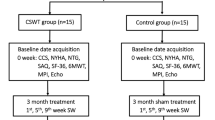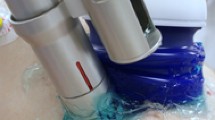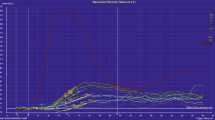Abstract
We have previously demonstrated that cardiac shock wave therapy (CSWT) effectively improves myocardial ischemia through coronary neovascularization both in a porcine model of chronic myocardial ischemia and in patients with refractory angina pectoris (AP). In this study, we further addressed the efficacy and safety of CSWT in a single-arm multicenter study approved as a highly advanced medical treatment by the Japanese Ministry of Health, Labour and Welfare. Fifty patients with refractory AP [mean age 70.9 ± 12.6 (SD) years, M/F 38/12] without the indications of percutaneous coronary intervention (PCI) or coronary artery bypass grafting (CABG) were enrolled in 4 institutes in Japan. Ischemic myocardial regions in the left ventricle (LV) were identified by drug-induced stress myocardial perfusion imaging (MPI). Shock waves (200 shots/spot at 0.09 mJ/mm2) were applied to 40–60 spots in the ischemic myocardium 3 times in the first week. The patients were followed up for 3 months thereafter. Forty-one patients underwent CSWT and completed the follow-up at 3 months. CSWT markedly improved weekly nitroglycerin use [from 3.5 (IQR 2 to 6) to 0 (IQR 0 to 1)] and the symptoms [Canadian Cardiovascular Society functional class score, from 2 (IQR 2 to 3) to 1 (IQR 1 to 2)] (both P < 0.001). CSWT also significantly improved 6-min walking distance (from 384 ± 91 to 435 ± 122 m, P < 0.05). There were no significant changes in LV ejection fraction evaluated by echocardiography and LV stroke volume evaluated by cardiac magnetic resonance imaging (from 56.3 ± 14.7 to 58.8 ± 12.8%, P = 0.10, and from 52.3 ± 17.4 to 55.6 ± 15.7 mL, P = 0.15, respectively). Percent myocardium ischemia assessed by drug-induced stress MPI tended to be improved only in the treated segments (from 16.0 ± 11.1 to 12.1 ± 16.2%, P = 0.06), although no change was noted in the whole LV. No procedural complications or adverse effects related to the CSWT were noted. These results of the multicenter trial further indicate that CSWT is a useful and safe non-invasive strategy for patients with refractory AP with no options of PCI or CABG.




Similar content being viewed by others
References
Roth GA, Forouzanfar MH, Moran AE, Barber R, Nguyen G, Feigin VL, Naghavi M, Mensah GA, Murray CJ (2015) Demographic and epidemiologic drivers of cardiovascular mortality. N Engl J Med 372:1333–1341
Williams B, Menon M, Satran D, Hayward D, Hodges JS, Burke MN, Johnson RK, Pulose AK, Traverse JH, Henry TD (2010) Patients with coronary artery disease no amenable to traditional revascularization prevalence and 3-year mortality. Catheter Cardiovasc Interv 75:886–891
Henry TD, Satran D, Hodges JS, Johnson RK, Poulose AK, Campbell AR, Garberich RF, Bart BA, Olson RE, Boisjolie CR, Harvey KL, Amdt TL, Traverse JH (2013) Long-term survival in patients with refractory angina. Eur Heart J 34:2683–2688
Jespersen L, Abildstrom SZ, Hvelplund A, Prescott E (2013) Persistent angina: highly prevalent and associated with long-term anxiety, depression, low physical functioning, and quality of life in stable angina pectoris. Clin Res Cardiol 102:571–581
Attanasio S, Schaer G (2011) Therapeutic angiogenesis for the management of refractory angina: current concepts. Cardiovasc Ther 29:e1–e11
Nishida T, Shimokawa H, Oi K, Tatewaki H, Uwatoku T, Abe K, Matsumoto Y, Kajihara N, Eto M, Matsuda T, Yasui H, Takeshita A, Sunagawa K (2004) Extracorporeal cardiac shock wave therapy markedly ameliorates ischemia-induced myocardial dysfunction in pigs in vivo. Circulation 110:3055–3061
Fukumoto Y, Ito A, Uwatoku T, Matoba T, Kishi T, Tanaka H, Takeshita A, Sunagawa K, Shimokawa H (2006) Extracorporeal cardiac shock wave therapy ameliorates myocardial ischemia in patients with severe coronary artery disease. Coron Artery Dis 17:63–70
Kikuchi Y, Ito K, Ito Y, Shiroto T, Tsuburaya R, Aizawa K, Hao K, Fukumoto Y, Takahashi J, Takeda M, Nakayama M, Yasuda S, Kuriyama S, Tsuji I, Shimokawa H (2010) Double-blind and placebo-controlled study of the effectiveness and safety of extracorporeal cardiac shock wave therapy for severe angina pectoris. Circ J 74:589–591
Miller TD, Askew JW, Herrmann J (2014) Assessing clinical impact of myocardial perfusion studies: ischemia or other prognostic indicators? Curr Cardiol Rep 16:465
Khattab AA, Brodersen B, Schuermann-Kuchenbrandt D, Beurich H, Tölg R, Geist V, Schafer T, Richardt G (2007) Extracorporeal cardiac shock wave therapy: first experience in the everyday practice for treatment of chronic refractory angina pectoris. Int J Cardiol 121:84–85
Ito Y, Ito K, Shiroto T, Tsuburaya R, Yi GJ, Takeda M, Fukumoto Y, Yasuda S, Shimokawa H (2010) Cardiac shock wave therapy ameliorates left ventricular remodeling after myocardial ischemia-reperfusion injury in pigs in vivo. Coron Artery Dis 21:304–301
Gotte G, Amelio E, Russo S, Marlinghaus E, Musci G, Suzuki H (2002) Short-time non-enzymatic nitric oxide synthesis from l-arginine and hydrogen peroxide induced by shock waves treatment. FEBS Lett 520:153–155
Mariotto S, Cavalieri E, Amelio E, Ciampa AR, de Prati AC, Marlinghaus E, Russo S, Suzuki H (2005) Extracorporeal shock waves: from lithotripsy to anti-inflammatory action by NO production. Nitric Oxide 12:89–96
Mariotto S, de Prati AC, Cavalieri E, Amelio E, Marlinghaus E, Suzuki H (2009) Extracorporeal shock wave therapy in inflammatory diseases: molecular mechanism that triggers anti-inflammatory action. Curr Med Chem 16:2366–2372
Alunni G, Barbero U, Vario A, D’amico S, Pianelli M, Zema D, Bongiovanni F, Gaita F (2017) The beneficial effect of extracorporeal shockwave myocardial revascularization: 2 years of follow-up. Cardiovasc Revasc Med 18:572–576
Nirala S, Wang Y, Peng YZ, Yang P, Guo T (2016) Cardiac shock wave therapy shows better outcomes in the coronary artery disease patients in a long term. Eur Rev Med Pharmacol Sci 20:330–338
Aicher A, Heeschen C, Sasaki K, Urbich C, Zeiher AM, Dimmeler S (2006) Low-energy shock wave for enhancing recruitment of endothelial progenitor cells: a new modality to increase efficacy of cell therapy in chronic hind limb ischemia. Circulation 114:2823–230
Fu M, Sun CK, Lin YC, Wang CJ, Wu CJ, Ko SF, Chua S, Sheu JJ, Chiang CH, Shao PL, Leu S, Yip HK (2011) Extracorporeal shock wave therapy reverses ischemia-related left ventricular dysfunction and remodeling: molecular-cellular and functional assessment. PLoS One 6:e24342
Apfel RE (1982) Acoustic cavitation: a possible consequence of biochemical uses of ultrasound. Br J Cancer Suppl 5:140–146
Fisher AB, Chien S, Barakat AI, Nerem RM (2001) Endothelial cellular response to altered shear stress. Am J Physiol Lung Cell Mol Physiol 281:L529–L533
Chatzizisis YS, Coskun AU, Jonas M, Edelman ER, Feldman CL, Stone PH (2007) Role of endothelial shear stress in the natural history of coronary atherosclerosis and vascular remodeling. J Am Coll Cardiol 49:2379–2393
Hahn C, Schwartz MA (2009) Mechanotransduction in vascular physiology and atherogenesis. Nat Rev Mol Cell Biol 10:53–62
Li YS, Haga JH, Chien S (2005) Molecular basis of the effects of shear stress on vascular endothelial cells. J Biomech 38:1949–1971
Traub O, Berk BC (1998) Laminar shear stress mechanisms by which endothelial cells transduce an atheroprotective force. Arterioscler Thromb Vasc Biol 18:677–685
Hatanaka K, Ito K, Shindo T, Kagaya Y, Ogata T, Eguchi K, Kurosawa R, Shimokawa H (2016) Molecular mechanisms of the angiogenic effects of low-energy shock wave therapy: roles of mechanotransduction. Am J Physiol Cell Physiol 311:C378–C385
Ha CH, Kim S, Chung J, An SH, Kwon K (2013) Extracorporeal shock wave stimulates expression of the angiogenic gene via mechanosensory complex in endothelial cells: mimetic effect of fluid shear stress in endothelial cells. Int J Cardiol 168:4168–4177
Briones E, Lacalle JR, Marin I (2009) Transmyocardial laser revascularization versus medical therapy for refractory angina. Cochrane Database Syst Rev 1:CD003712
Osterele SN, Sanborn TA, Ali N, Resar J, Ramee SR, Heuser R, Dean L, Knopf W, Schofield P, Schaer GL, Reeder G, Masden R, Yeung AC, Burkhoff D (2000) Percutaneous transmyocardial laser revascularization for severe angina: the PACIFIC randomized trial. Potential class improvement from intramyocardial channels. Lancet 356:1705–1710
Salem M, Rotevatn S, Nordrehaug JE (2006) Long-term results following percutaneous myocardial laser therapy. Coron Artery Dis 17:385–390
Taylor RS, De Vries J, Bucher E, Dejongste MJ (2009) Spinal cord stimulation in the treatment of refractory angina: systematic review and meta-analysis of randomized controlled trials. BMC Cardiovasc Disord 9:13
Serizawa F, Ito K, Kawamura K, Tsuchida K, Hamada Y, Zukeran T, Shimizu T, Akamatsu D, Hashimoto M, Goto H, Watanabe T, Sato A, Shimokawa H, Satomi S (2012) Extracorporeal shock wave therapy improves the walking ability of patients with peripheral artery disease and intermittent claudication. Circ J 76:1486–1493
Saggini R, Figus A, Troccola A, Cocco V, Saggini A, Scuderi N (2008) Extracorporeal shock wave therapy for management of chronic ulcers in the lower extremities. Ultrasound Med Biol 34:1261–1271
Moretti B, Notarnicola A, Maggio G, Moretti L, Pascone M, Tafuri S, Patella V (2009) The management of neuropathic ulcer of the foot in diabetes by shock wave therapy. BMC Musculoskelet Disord 10:54
Saito S, Ishii T, Kamogawa Y, Watanabe R, Shirai T, Fujita Y, Shirota Y, Fujii H, Ito K, Shimokawa H, Yamaguchi T, Kawaguchi Y, Harigae H (2016) Extracorporeal shock wave therapy for digital ulcers of systemic sclerosis: a phase 2 pilot study. Tohoku J Exp Med 238:39–47
Serizawa F, Ito K, Matsubara M, Sato A, Shimokawa H, Satomi S (2011) Extracorporeal shock wave therapy induces therapeutic lymphangiogenesis in a rat model of secondary lymphedema. Eur J Vasc Endovasc Surg 42:254–260
Ogden JA, Alvarez RG, Levitt R, Marlow M (2001) Shock wave therapy (Orthotripsy) in musculoskeletal disorders. Clin Orthop Relat Res 387:22–40
Birnbaum K, Wirtz DC, Siebert CH, Heller KD (2002) Use of extracorporeal shock-wave therapy (ESWT) in the treatment of non-unions. A review of the literature. Arch Orthop Trauma Surg 122:324–330
Wang CJ (2012) Extracorporeal shockwave therapy in musculoskeletal disorders. J Orthop Surg Res 7:11
Al-Abbad H, Simon JV (2013) The effectiveness of extracorporeal shock wave therapy on chronic Achilles tendinopathy: a systematic review. Foot Ankle Int 34:33–41
Yamaya S, Ozawa H, Kanno H, Kishimoto KN, Sekiguchi A, Tateda S, Yahata K, Ito K, Shimokawa H, Itoi E (2014) Low-energy extracorporeal shock wave therapy promotes VEGF expression and neuroprotection and improves locomotor recovery after spinal cord injury. J Neurosurg 121:1514–1525
Yahata K, Kanno H, Ozawa H, Yamaya S, Tateda S, Ito K, Shimokawa H, Itoi E (2016) Low-energy extracorporeal shock wave therapy for promotion of vascular endothelial growth factor expression and angiogenesis and improvement of locomotor and sensory functions after spinal cord injury. J Neurosurg Spine 25:745–755
Angulo JC, Arance I, de Las Heras MM, Meilan E, Esquinas C, Andres EM (2017) Efficacy of low-intensity shock wave therapy for erectile dysfunction: a systematic review and meta-analysis. Actas Urol Esp 41:479–490
Al-Lamee R, Thompson D, Dehbi HM, Sen S, Tang K, Davies J, Keeble T, Mielewczik M, Kaprienlian R, Malik IS, Nijjer SS, Petraco R, Cook C, Ahmad Y, Howard J, Baker C, Sharp A, Gerber R, Talwar S, Assomull R, Mayet J, Wensel R, Collier D, Shun-Shin M, Thom SA, Davies JE, Francis DP, ORBITA investigators (2018) Percutaneous coronary intervention in stable angina (ORBITA): a double-blind, randomised controlled trial. Lancet 391:31–40
Yang P, Guo T, Wang W, Peng YZ, Wang Y, Zhou P, Luo ZL, Cai HY, Zhao L, Yang HW (2013) Randomized and double-blind controlled clinical trial of extracorporeal cardiac shock wave therapy for coronary heart disease. Heart Vessels 28:284–291
Schmid JP, Capoferri M, Wahl A, Eshtehardi P, Hess OM (2013) Cardiac shock wave therapy for chronic refractory angina pectoris. A prospective placebo-controlled randomized trial. Cardiovasc Ther 31:e1–e6
Leibowitz D, Weiss AT, Rott D, Durst R, Lotan C (2013) The efficacy of cardiac shock wave therapy in the treatment of refractory angina: a pilot prospective, randomized, double-blind trial. Int J Cardiol 167:3033–3034
Alunni G, Marra S, Meynet I, D’amico M, Elisa P, Fanelli A, Molinaro S, Garrone P, Deberardinis A, Campana M, Lerman A (2015) The beneficial effect of extracorporeal shockwave myocardial revascularization in patients with refractory angina. Cardiovasc Revasc Med 16:6–11
Wang Y, Guo T, Cai HY, Ma TK, Tao SM, Sun S, Chen MQ, Gu Y, Pang JH, Xiao JM, Yang XY, Yang C (2010) Cardiac shock wave therapy reduces angina and improves myocardial function in patients with refractory coronary artery disease. Clin Cardiol 33:693–699
Kaller M, Faber L, Bogunovic N, Horstkotte D, Burchert W, Lindner O (2015) Cardiac shock wave therapy and myocardial perfusion in severe coronary artery disease. Clin Res Cardiol 104:843–849
Vasyuk YA, Hadzegova AB, Shkolnik EL, Kopeleva MV, Krikunova OV, Iouchtchouk EN, Aronova EM, Ivanova SV (2010) Initial clinical experience with extracorporeal shock wave therapy in treatment of ischemic heart failure. Congest Heart Fail 16:226–230
Acknowledgments
We thank Dr. Ernest H. Marlinghaus (Storz Medical AG, Switzerland) for valuable comments on our study. We also appreciate Daisuke Ito, a radiology technologist, for preparing blinded images of MPI.
Funding
This study was supported by grants-in-aid for scientific research grant from the Japan agency for medical research and development (JP15lk0201011).
Author information
Authors and Affiliations
Corresponding author
Ethics declarations
Conflict of interest
The authors declare that they have no conflict of interest.
Ethical approval
All procedures performed in this study involving human participants were in accordance with the ethical standards of the institutional and national research committee and with the 1964 Helsinki declaration and its later amendments or comparable ethical standards.
Informed consent
Informed consent was obtained from all individual participants included in this study.
Rights and permissions
About this article
Cite this article
Kikuchi, Y., Ito, K., Shindo, T. et al. A multicenter trial of extracorporeal cardiac shock wave therapy for refractory angina pectoris: report of the highly advanced medical treatment in Japan. Heart Vessels 34, 104–113 (2019). https://doi.org/10.1007/s00380-018-1215-4
Received:
Accepted:
Published:
Issue Date:
DOI: https://doi.org/10.1007/s00380-018-1215-4




